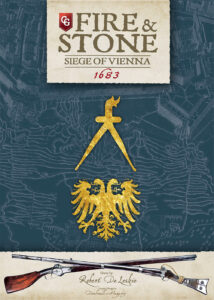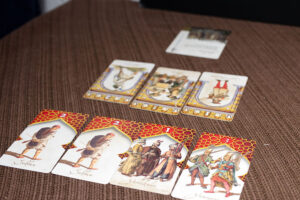 The year is 1683. 100,000 Ottoman soldiers arrive outside Habsburg, the capital city of Vienna. Inside those city walls are 10,000 infantry and militia. Their goal? Hold off the Ottoman advance for Gandalf to arrive from the east on the 3rd day. Oh wait, I’m getting my sieges mixed up. They need to wait for the relief force to arrive and break the siege.
The year is 1683. 100,000 Ottoman soldiers arrive outside Habsburg, the capital city of Vienna. Inside those city walls are 10,000 infantry and militia. Their goal? Hold off the Ottoman advance for Gandalf to arrive from the east on the 3rd day. Oh wait, I’m getting my sieges mixed up. They need to wait for the relief force to arrive and break the siege.
Fire & Stone: Siege of Vienna 1683 is a new card-driven war game published by Capstone Games. Designed by Robert DeLeskie, this two-player only game will take you about 60-90 minutes to play.
Gameplay Overview:
Fire and Stone is an asymmetrical game, with each side having somewhat different goals. The Ottoman player wants to break through to a few specific territories on the Habsburg side of the board, while the defenders need to hold off until the end of the 5th round. There are a few other ways to win as well, such as reducing your opponent’s morale to zero or murdering all their troops.

Each round, players will draw a hand of five cards from their deck. Much like many card-driven games, these cards can either be used for a standard action, or for the event on the card. Most events are similar to the standard actions, but clearly better. For the most part, the main actions you take will be:
• Dig: Draw shovels from your bag, and when you have enough, you can destroy an enemy fortification.
• Fortify: Add an improvised fortification to a hex you control
• Bombard/Barrage: Fire your cannons, trying to kill enemy soldiers.
• Attack: Start a battle in an adjacent hex.

Battles have quite a few steps but are still fairly straightforward and are probably the most interesting part of the game. When a battle is declared, each side will choose 3 (or more for the Ottomans) troop cards from their deck to play face-down in the battle. All cards in your deck are available to be chosen and a soldier’s power ranges from 1-3. Players can also choose one of their 5 tactics cards to use in the battle. However, they only have 5 to use for the whole game, so once they are out, they won’t have any more to use.
Then both sides then reveal their cards and apply the effects of tactics cards (if any). If the attacker is attacking a region with a fortification, they must send troops to the back line, losing their strength for the battle. Then it’s time for canons. The Ottoman player gets to roll a die for each adjacent canon, while the Habsburg player gets to roll dice for ALL their canons on the map. Each six rolled eliminates an enemy troop in the battle. Whoever has the highest strength left wins the battle and claims the territory. Any surviving troops are placed in a discard pile, able to be used again the following round. Any killed troops are out of the game.
Players will alternate taking turns until both players have played five actions or have passed. At the start of the next round, players will draw five new Strategy cards and start the round over. When one side achieves its objective, they win!

Game Experience:
I’ll admit to knowing next to nothing about the Siege of Vienna before playing the game. Well, I still know next to nothing as well, but I found the theme pretty interesting so I was keen to give it a try. I’m not much of a historical war gamer, but I do love a good siege game. And bonus points if it’s asymmetrical. The other thing that got me interested was that it was a card-driven game. I absolutely loved Watergate, so I was curious to see how Fire and Stone played.
This was a game that we definitely needed a learning game to wrap our heads around the strategy. While the game isn’t complicated, there are still quite a few moving parts. Thankfully, there is an excellent player aid for both sides that help with the learning curve. Battles is probably the hardest thing to gronk, as the rest of the actions are simple to understand.

And it’s those battles that will keep you coming back for more. The main actions are fine, but we found ourselves glued to the board during battles. Mining, bombarding, entrenching, and fortifying? Those were just there to help us prep for a battle. Even firing your cannons during a bombard action, which sounds really cool, requires at least 2 6’s to be effective. So, it requires a degree of luck (more on that in a bit).
I will say that the Ottomans definitely have the deck stacked against them a little. I’m guessing this is for historical accuracy. Because while they have more and stronger troops, they are also going up against fortified positions and superior canon power. The Habsburg player being allowed to fire all their canons (they start with 9) each time they fire can really decimate the Ottoman forces.
The battles themselves are a really tense affair. It can also be difficult to decide when you are going play one of your very limited tactics cards, because you need them to be effective. Each one can swing the tide of a tight battle to your side. This will not be a game where the Ottomans will be using their superior numbers to steamroll the defenders. Battles are usually very tight affairs with only a point or two deciding the difference.

The biggest issue I had with the game though is how swingy the dice make it. Normally, I’m a fan of tons of dice rolling in my combat games. But the action economy in Fire and Stone is extremely tight. You get 5 total actions a round, and these are split between battles and preparing for the next one. We had some battles where the ottoman player should have steamrolled the defender, but a lucky roll just wiped out their chances. Thankfully, battle casualties are capped at 2, but when you can only send 3-5 cards in a battle, and you automatically lose some to fortifications, which can make a massive difference.
At one point in the game as the Ottoman player, I had about 5 cards left in my troop deck, while the Habsburg player had only suffered 3 casualties the entire game. Personally, I would have preferred a more deterministic battle than one that leaned so heavily on rolls of the dice. Sometimes all the preparation in the world can’t hold up when the dice are rolling against you.
Final Thoughts:
Fire and Stone: The Siege of Vienna is a good game that historical war game buffs could really enjoy. If you are a fan of the more political card-driven games, such as Watergate or Twilight Struggle, I’d probably steer clear of this one as the card play takes a backseat to battles (and the dice involved). That being said, the battles are tense, with interesting decisions that need to be made. If you are ok with a little bit of luck pressing down on your carefully laid plans, Fire and Ice is worth checking out.
Final Score: 3.5 Stars – A solid card driven game that appears to lean into the historical accuracy of its theme.
 Hits:
Hits:
• Tense battles
• Tight action economy
• Great production values with solid player aids
Misses:
• Dice can make the game a tad too swingy
• Ottomans seem to be at a slight disadvantage





















